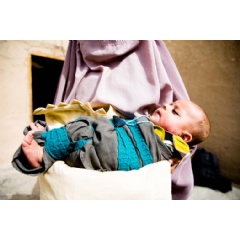Geneva Palais Briefing Note: Children’s nutrition at risk in Afghanistan
This is a summary of what was said by UNICEF spokesperson Christophe Boulierac – to whom quoted text may be attributed – at press briefing at the Palais des Nations in Geneva.
Among the 2 million children under the age of five years who are suffering from acute malnutrition, 600,000 children are currently suffering from severe acute malnutrition, which is the most dangerous form of undernutrition in children.
Afghanistan is one of the countries with the highest number of children under the age of five suffering from severe acute malnutrition, alongside Yemen and South Sudan.
In 2018, UNICEF – the sole provider of ready-to-use therapeutic food for malnourished children in Afghanistan – could only target less than 50 per cent of severely malnourished children (approximately 275,000) across the country due to limited supplies. For 2019, UNICEF plans to reach 60 per cent of severely malnourished children (375,000). However, we will not be able to reach them if we do not receive $7 million USD in funding (equivalent to 107,000 cartons of ready-to-use therapeutic food) within the next three weeks.
If these funds are not received, we will not be able to procure the ready-to-use therapeutic food and ensure their distribution to the 1,300 health facilities supported by UNICEF across all 34 provinces of Afghanistan.
Any child suffering from severe acute malnutrition is in crisis and requires urgent treatment to survive.
So, what will happen if we do not receive these funds within three weeks? We cannot tell you how many children will die. But we can tell you that a child with severe acute malnutrition is 11 times more likely to die than their healthy peers. Acute malnutrition reduces resistance to disease. And in Afghanistan, only 1 in 2 children is vaccinated.
The situation is further complicated by ongoing violence, climatic extremes (droughts and flash floods) multiple displacements, growing food insecurity and improper feeding habits. The impact of the drought in 2018 has made matters worse and is further aggravating the poor nutritional situation for children this year. Data from 2018 showed a 25 per cent increase in children suffering from severe acute malnutrition in drought-affected areas. The findings of the most recent nutrition surveys across Afghanistan also show that 22 out of 34 provinces are currently above the emergency threshold of acute malnutrition.
We have had to put our plans to further decentralize treatment for malnutrition – bringing it closer to children in need – on hold due to limited resources. Without an improvement in the overall food and nutrition security situation, which requires urgent funding, the nutritional status of children in Afghanistan is likely to further deteriorate.
UNICEF’s nutrition program in Afghanistan is only 50 per cent funded ($13 million USD received out of $26,500,00 million USD required) for 2019.
About UNICEFUNICEF works in some of the world’s toughest places, to reach the world’s most disadvantaged children. Across more than 190 countries and territories, we work for every child, everywhere, to build a better world for everyone.
( Press Release Image: https://photos.webwire.com/prmedia/7/241289/241289-1.jpg )
WebWireID241289
This news content was configured by WebWire editorial staff. Linking is permitted.
News Release Distribution and Press Release Distribution Services Provided by WebWire.
